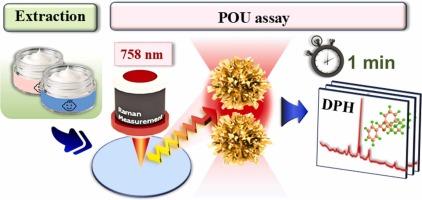利用sers活性金刺猬颗粒/MOF-801沉积在纤维素纳米原纤维薄膜上快速检测儿童化妆品中的苯海拉明
IF 3.7
1区 化学
Q1 CHEMISTRY, ANALYTICAL
引用次数: 0
摘要
公众对儿童化妆品中非法添加苯海拉明(DPH)的关注突出表明迫切需要强有力的使用点(POU)检测策略。为了解决这一问题,我们提出了一种基于表面增强拉曼散射(SERS)的方法,用于快速识别和定量儿童面霜中的DPH。我们的方法利用了一种多功能传感器,该传感器包括由金属有机框架-801 (MOF-801)和刺猬状金纳米颗粒(GHPs)修饰的纤维素纳米纤维(CNFs)薄膜。合成的GHPs/MOF-801/CNF传感器同时作为SERS活性底物和吸附剂,利用丰富的纳米间隙和GHPs的尖锐尖端来放大SERS信号。多孔CNF和MOF-801确保了高效和选择性的提取,而sers活性GHPs显著提高了检测灵敏度。SERS强度与对数浓度的相关r值在0.926 ~ 0.978之间,检出限低至0.4 ppb,适用于禁用DPH添加剂的检测。该方法成功地应用于两个品牌的乳膏样品,结果与常规色谱法的结果非常接近。该方法的主要优点是其卓越的效率,在11分钟内完成检测过程,使其成为一种用户友好的POU检测儿童化妆品中的禁用添加剂。本文章由计算机程序翻译,如有差异,请以英文原文为准。

Rapid Detection of Diphenhydramine in Children’s Cosmetics using SERS-active Gold Hedgehog Particles/MOF-801 deposited on cellulose nanofibrils films
Public concern regarding the illicit addition of diphenhydramine (DPH) to children’s cosmetics highlights the urgent need for robust point-of-use (POU) detection strategies. In addressing this concern, we present a surface-enhanced Raman scattering (SERS)-based method for rapidly identifying and quantifying DPH in children’s creams. Our approach utilizes a multifunctional sensor comprising a cellulose nanofibrils (CNFs) film modified with metal-organic framework-801 (MOF-801) and hedgehog-like gold nanoparticles (GHPs). The synthesized GHPs/MOF-801/CNF sensor functions as both a SERS-active substrate and a sorbent, leveraging abundant nanogaps and sharp tips of the GHPs to amplify SERS signals. The porous CNF and MOF-801 ensure efficient and selective extraction, while the SERS-active GHPs significantly enhance detection sensitivity. The correlation between SERS intensity and logarithmic concentration yielded R-values between 0.926 and 0.978, with the detection limit as low as 0.4 ppb, making it suitable for detecting prohibited DPH additives. This method was successfully applied to two brands of cream samples, with results closely aligning with those from routine chromatography. This method’s key advantage is its exceptional efficiency, completing the detection process within 11 min, making it a user-friendly POU assay for detecting prohibited additives in children’s cosmetics.
求助全文
通过发布文献求助,成功后即可免费获取论文全文。
去求助
来源期刊

Sensors and Actuators B: Chemical
工程技术-电化学
CiteScore
14.60
自引率
11.90%
发文量
1776
审稿时长
3.2 months
期刊介绍:
Sensors & Actuators, B: Chemical is an international journal focused on the research and development of chemical transducers. It covers chemical sensors and biosensors, chemical actuators, and analytical microsystems. The journal is interdisciplinary, aiming to publish original works showcasing substantial advancements beyond the current state of the art in these fields, with practical applicability to solving meaningful analytical problems. Review articles are accepted by invitation from an Editor of the journal.
 求助内容:
求助内容: 应助结果提醒方式:
应助结果提醒方式:


